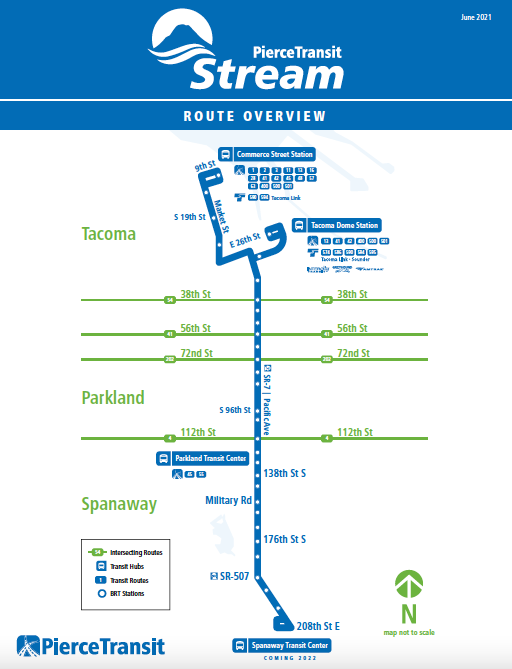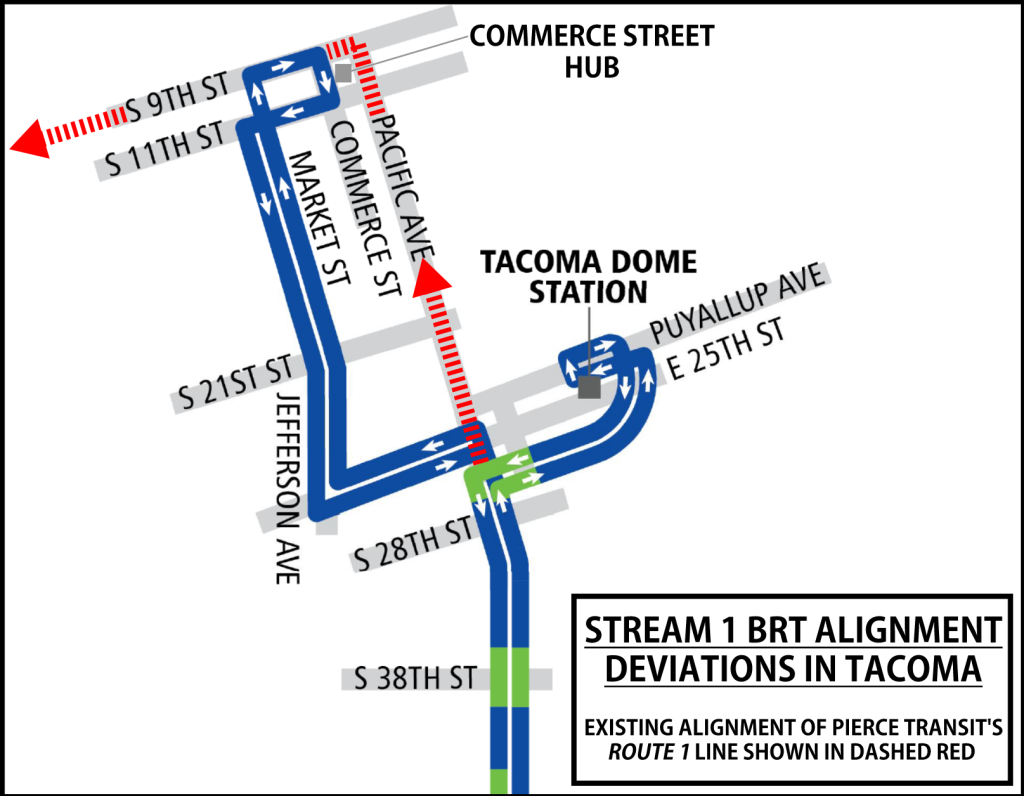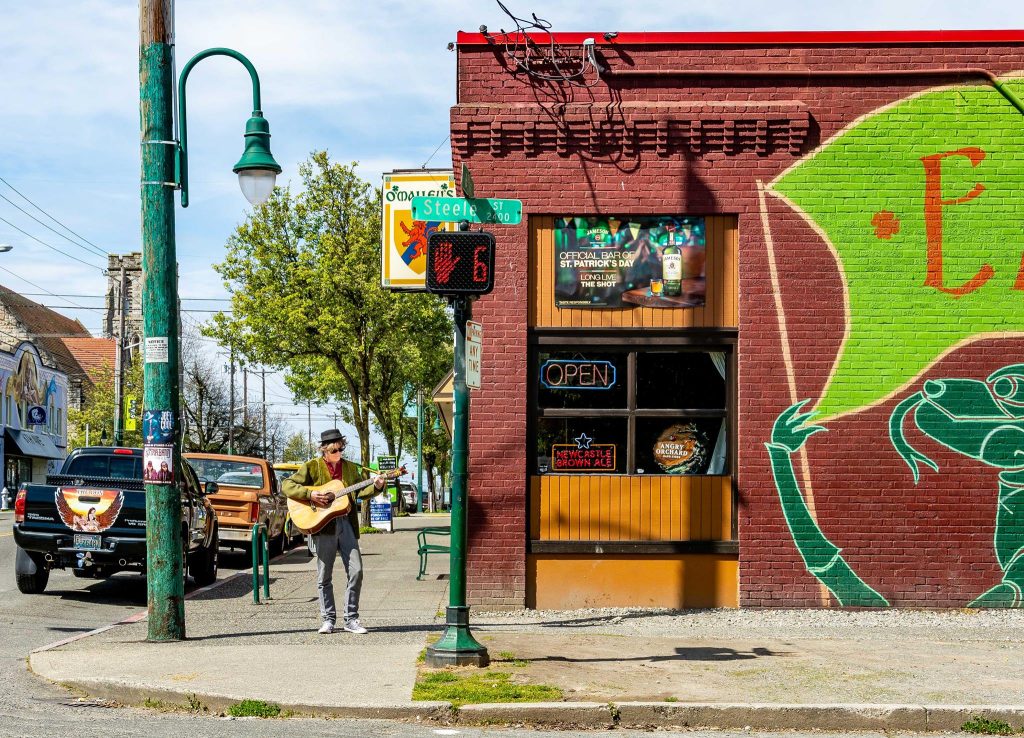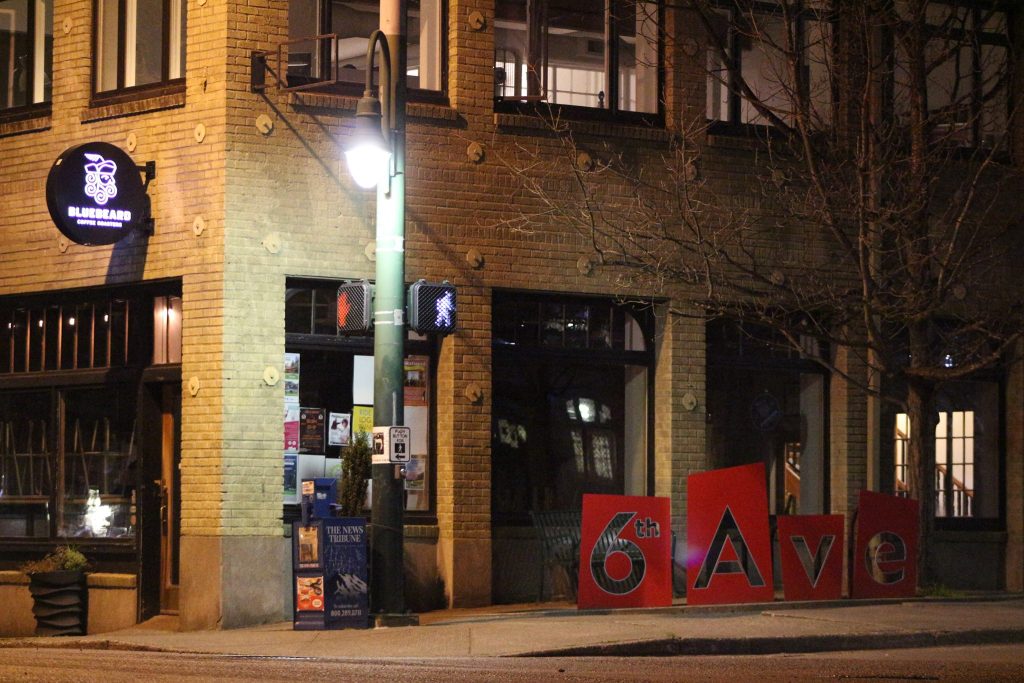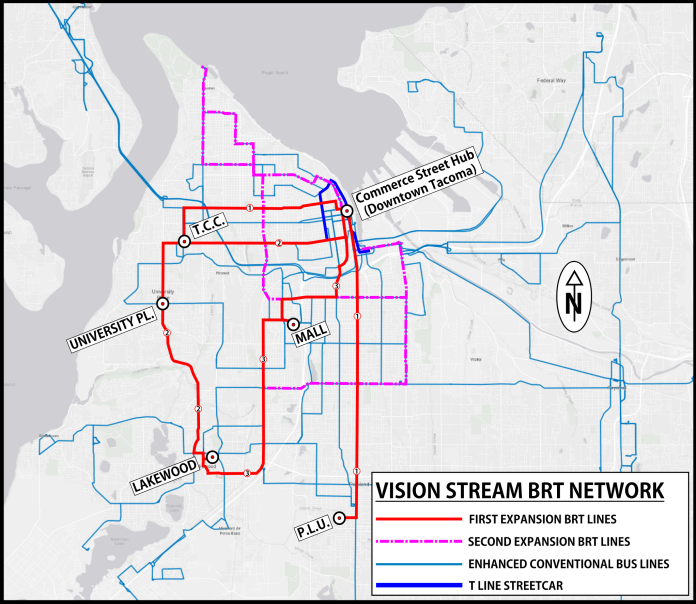
Pierce Transit’s first bus rapid transit (BRT) line remains in the design phase, the first line of a system in Pierce County called Stream. The agency is aware that one line is not much of a system and has directed consultants to conduct a planning study of the next four fixed routes to be upgraded to BRT. This Stream System Expansion Study (SSES) should be of great interest to Tacoma area residents.
The cost-effective nature of BRT makes it a good choice for Tacoma, with its developed street network and modest population densities. A thoughtfully planned BRT system would be a tremendous asset to Tacoma’s transit system. Despite early planning errors impairing the Stream 1 corridor and the predictable mega-project growing pains for Pierce Transit, this remains true today — especially if planners create a vision that builds on Tacoma’s strengths for BRT service.
The SSES could be an important tool for development of the transportation network if it was being properly utilized. Unfortunately, this is not the case, and the study runs the risk of not only cementing into place a flawed Stream 1 corridor, but keeping the region unprepared to make strategic investments toward a quality BRT system.
Before new routes are developed, the fundamental problems of the first Stream line should be addressed by the study, which primarily impact central Tacoma. These improvements are not even being considered, and other choices are being deliberated that would have a profound impact on the city’s transit network. For these reasons, City of Tacoma must play a proactive role in BRT system development.
More so than being participants in another agency’s expansion study, Tacoma, in collaboration with Pierce Transit, must lead the way in the development and financing of an urban bus system that adequately responds to local needs, such as the example set by Seattle.
The success of peer projects in the state has proven that the BRT model can be successful in Tacoma. Additionally, the rising cost of local rail projects, especially the T Line Hilltop Extension, highlight the financial advantages of BRT. For instance, with the Stream 1 line having a per mile cost pegged at $15.5 million and featuring dedicated bus lanes, and the Hilltop Extension costing $118 million per mile for rails laid into vehicle traffic lanes, BRT is on track to provide a better product for Tacoma and do so at a fraction of the cost of any streetcar alternative.
Indeed, had all Hilltop and Tacoma Community College (TCC) streetcar extension funds been repurposed for BRT, nearly 50 miles of BRT could be in development in Tacoma today, instead of the expected 5.9 miles of streetcar rail. Using inflation-pegged figures for the TCC extension alone, over 35 miles of BRT could be financed, instead of just 3.5 miles of new rail.
The SSES should be focused on fixing Stream 1 planning errors and engaging in preliminary system planning. The improvements to Stream 1, by itself, would produce a BRT project of regional importance that is worthy of promotion by the study.
Evolving toward a better Stream 1
The Stream 1 corridor has serious flaws as an independent BRT line considering its mobility objectives, principally the elimination of the through-routing of the bus line it will replace, the Route 1. Other missteps include a new route deviation to Tacoma Dome Station, and a secondary deviation to Market Street that results in the termination of Pacific Avenue service into downtown, a storied transit corridor that is well over a century old. Both deviations add wasteful minutes to each trip into or out of Tacoma, despite a $250-million investment to speed up service via bus lanes, roundabouts and other improvements.
It is for these reasons that the current project should be viewed only as a temporary phase within a larger corridor build-out. This piece proposes that long-range plans be developed that would allow Stream 1 to evolve into an alignment that stretches 13.2-miles, from Tacoma Community College (TCC) to Pacific Lutheran University (PLU), an intuitive and intelligent corridor. This proposal should be the focus of the SSES and expansion plans.
Such an evolution would construct for the South Sound a rapid transit backbone that would enliven Tacoma. A TCC to PLU Stream 1 line would be bookended by prominent educational institutions and tie together the downtown core, Hilltop medical jobs, and the densest neighborhoods in the county. The substantive portions of the original Stream 1 project, in terms of infrastructure investment, would largely be preserved for the evolved corridor. The overall length would also be reduced by 1.8 route miles, even while dramatically expanding coverage.
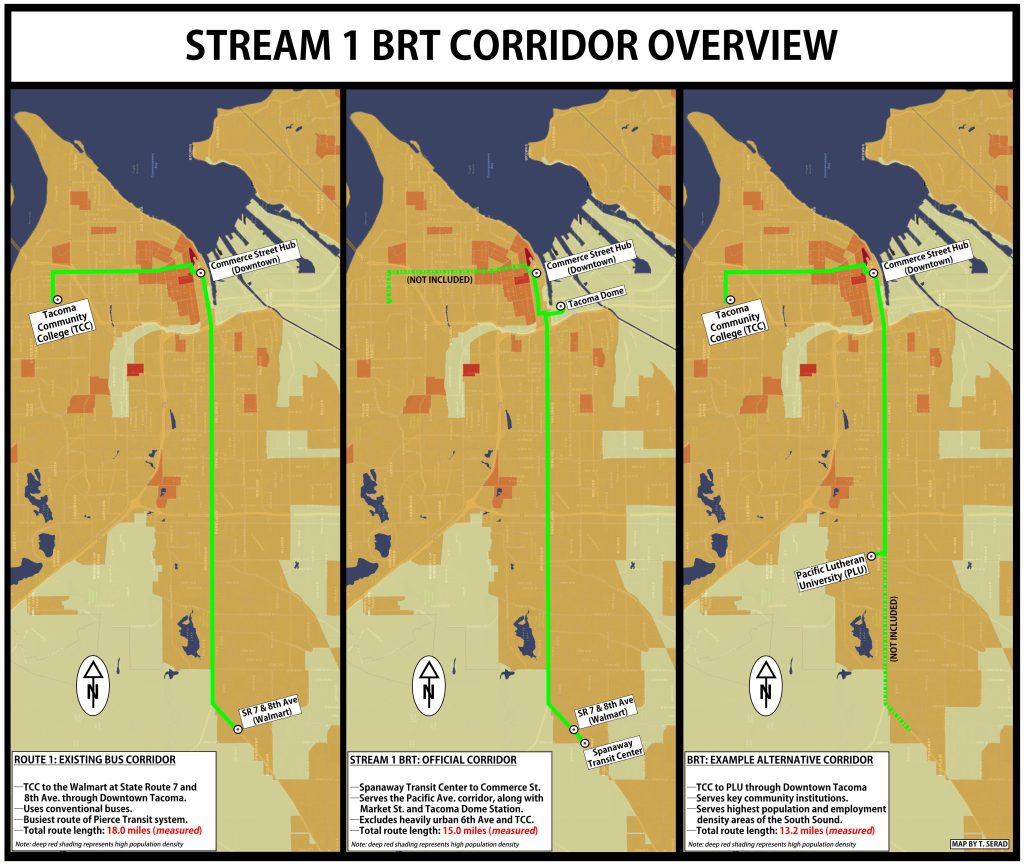
Achieving a complete build-out of Stream 1 from TCC to PLU would re-establish a critical, high-capacity transit artery within Tacoma through which all future BRT routes connect or intersect. All major neighborhood zones in Tacoma would be served by it, bridging the city’s notorious east-west divide. It eliminates transfers, irons out the kinks from the forthcoming line deviations, and becomes the principal route within a larger Stream BRT network. The evolution is essential if Tacoma to develop a BRT network that is more sophisticated than a hub-and-spoke system, offering better service and connections for people traveling across the city.
Should Sound Transit fail to deliver a Link connection to the Commerce Street Hub via ST4 (see here, here, and here), the expanded BRT route would even better serve Tacoma Dome Station. Riders throughout the city would be permitted to reach it without a transfer, reducing the burden of this route deviation for some riders. Critically, this evolution must be accomplished through new BRT service along Pacific and 6th Avenues, corrections to the major deficiencies of the current Stream 1 project.

For Pacific Avenue, two options exist to allow for adding dedicated bus lanes, should they be necessary for operational reliability. The first is the removal of angled parking lanes that currently clutter the avenue in the southbound direction. This may instigate a parking battle with area businesses. However, the angled parking lanes occupy an excessive amount of space, and contribute to or create delays across what should be the principal north-south throughway of the city. Additionally, the removal of these spaces may even negate the need for bus lanes since Pacific Avenue is generally free flowing.
The second option is for BRT to share the transit-dedicated lanes that have been already created for the streetcar, to include an expanded station. This is an arrangement found in transit systems the world over, with a comparable example found on Utrecht’s new Uithoflijn, as well as Seattle’s example. There are no insurmountable barriers to a Pacific Avenue BRT alignment into central Tacoma.
North of where the streetcar line darts northwest along Tollefson Plaza, bus lanes of limited length could deliver buses to 11th Street and the Commerce Street Hub. It is possible that general purpose lanes would be sufficient for this portion of the trip considering the reduced demand on Pacific Avenue north of the UWT campus.
Beyond the Commerce Street Hub and along 6th Avenue to TCC, a Stream 1 expansion demands extensive planning to effectively overlay a BRT system onto the existing street grid. This will introduce real and predictable challenges, and it will ultimately require sacrifices to existing parking along 6th Avenue.
For a growing city that is conscious of its climate impact, this is a worthwhile sacrifice. Additionally, as 6th Avenue is the principal east-west throughway for the city, the preservation of parking should not be of greater importance than the movement of goods and people across it — pedestrians and transit, in particular. Still, as other cities have discovered, there may exist right-of-way designs that thread enhanced bus facilities through the constrained corridor, and which would preserve some parking in the project area, alleviating some community concerns.
It also may be possible that intensive BRT infrastructure is not necessary throughout the corridor, further reducing impacts. For example, if a multi-million-dollar bus lane regularly saves only seconds of travel time, it may be value engineered out of the proposal. Substantial street modifications should only be accepted by designers when their benefit is pronounced. Modernizing 6th Avenue to host protected bike lanes in both directions is one example worthy of consideration, as is a sidewalk network rehab and a roundabout at Sprague and 6th Avenue.

Many of these proposals would require substantial public investment, but this is investment that is commensurate with the value of this corridor as a preeminent transportation artery. 6th Avenue is prime BRT territory, and the SSES should have been provided the mandate to explore it. This project should be a focus of City of Tacoma leaders, staff, and its relevant commissions, as well as Pierce Transit and Pierce County.
BRT system expansion troubles
Of course, the Stream 1 build-out envisioned by this article is not underway, nor even hinted at in SSES planning materials. Instead, the review is studying four route options that do not service 6th Avenue.
The four alternatives are being evaluated on the strength of their independent utility as a BRT line. This is in contrast to a study that advances a corridor that would begin to produce a network. The “system” in system expansion study appears to be a misnomer. Early study determinations elevate one line over another based on isolated route characteristics in a contest to be Pierce County’s next top BRT line. The SSES would preferably study how the new line may interact with Stream 1, enhance conventional bus services, and improve travel within the broader Pierce County.
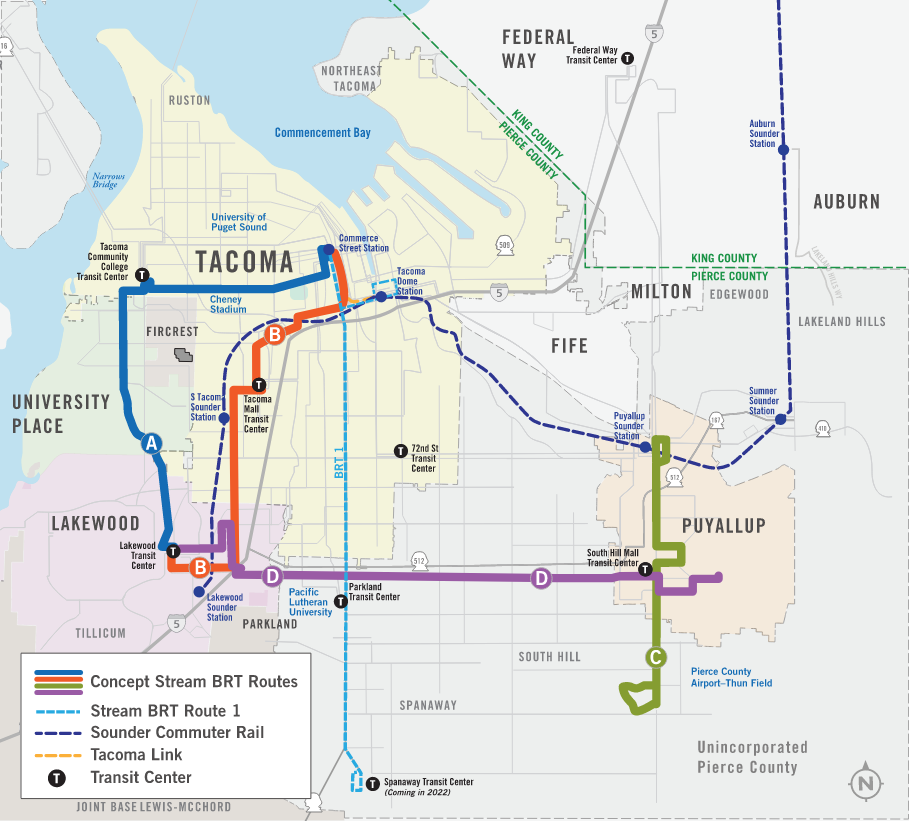
Additionally, pivotal alignment choices are up for debate. In the absence of a long-range BRT plan, one established through an analysis with the goal of producing an efficient system, Pierce Transit is working through the particulars in real time. Per recent public meetings, impactful decisions may be made on a whim.
Will new lines serve Downtown Tacoma or not at all (i.e. Tacoma Dome Station)? Should this line deviate to the Lincoln District? Should that line incorporate a potentially superior alignment? Should a new downtown approach utilize Market Street, Tacoma Avenue, or even Pacific Avenue, despite the effort spent relocating Stream 1 off of it? These are for the consultants to decide.
Adding to the confusion, one of the four options, Route 2 in the study, cannot even be properly considered because of the influence of Sound Transit on the Tacoma area transportation planning process. Whereas much has been written on Sound Transit’s choice to terminate Link outside of Downtown Tacoma, it is only one of several burdens the agency has imposed upon strategic planning in Tacoma and Pierce County. There is also the project to extend the streetcar along 19th Street from Hilltop to Tacoma Community College, with an optimistic opening set for 2041. The very existence of a long-range streetcar vision has been enough to reject a Route 2 BRT conversion, which uses a portion of the same right-of-way.
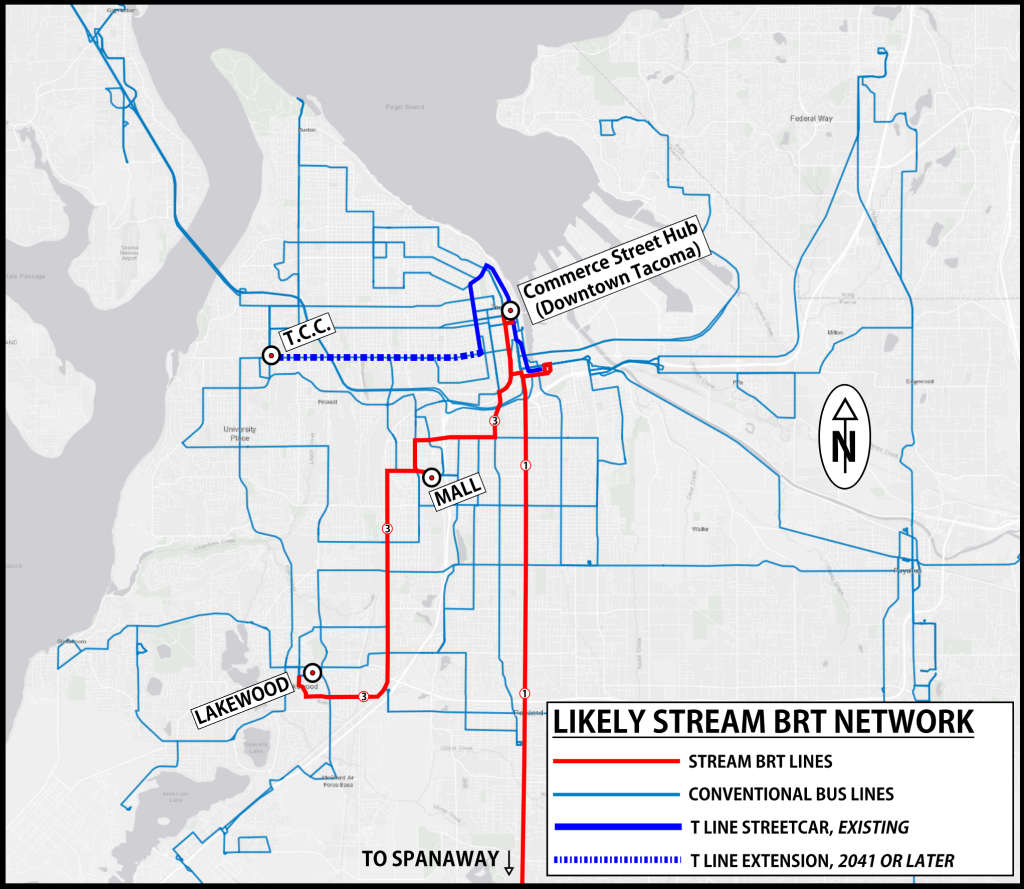
Considering the absence of a 6th Avenue option, Route 2 happens to be the best BRT alternative that the SSES is studying. Pierce Transit’s own materials have previously implied as much (see page 6, page 81). Route 2 has the second highest ridership in the Pierce Transit system with 739,468 yearly riders, besting the third busiest route by nearly 225,000 riders (see pages 92-93). Only the Route 1 is busier, at least before being cut in two for partial BRT service.
Route 2 features the essential ingredients that nourish successful rapid-transit ventures: a prominent city center, dense neighborhoods, educational institutions, and other community anchors. The line would provide a vital east-west BRT axis in Tacoma that connects with the north-south axis of Stream 1, the beginnings of a true network.
Pierce County voters rejected the suite of transportation projects offered under Sound Transit 3 ballot measure, including the college streetcar extension. Today, the specter of these Sound Transit projects now loom over the BRT expansion study and will directly influence the outcomes. Tacomans, despite having generally endorsed Sound Transit, should be concerned about this development, since a smart project like a Route 2 conversion into BRT will be blocked because of it.
Tacomans deserve real improvements to Route 2 on rational timeframes and costs. Excellent transit service on this corridor is needed now and should be delivered within years, not the decades required for a streetcar extension.
Planning a BRT system for Tacoma
Given the substantial time and cost savings, it makes sense for Tacoma to aggressively support a BRT system over streetcar routes to TCC and elsewhere — or Link service to the Tacoma Mall. Following the completion of the Stream 1 evolution proposed by this piece, and with “programmed” rail funds rededicated to BRT infrastructure, suddenly a high-capacity transit network comes into focus.
A Stream 1 line would whisk riders from PLU to TCC over 6th Avenue, a rapid transit spine for the city. At the Commerce Street Hub in Downtown, riders could easily transfer onto Stream 2 toward University Place, onto Stream 3 for a trip to the Tacoma Mall and Lakewood, or, if the stars aligned, board a Link train for a journey to Seattle.
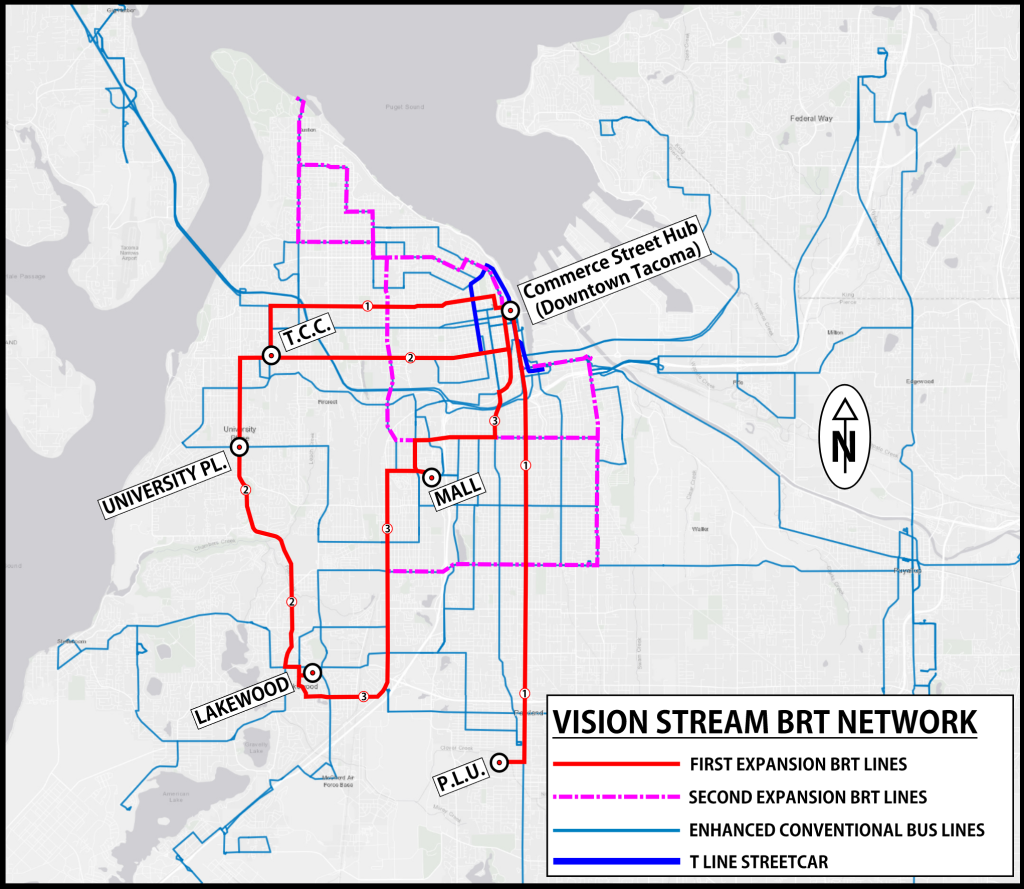
While this proposed BRT system is basic, it is highly effective at serving Tacoma. Overlaid onto the conventional bus system, it would be a sea-change for transit mobility in Tacoma and urbanized Pierce County. It could also be a harbinger of still more improvements to come. Consider successive BRT projects, especially an East Side offering over Portland Avenue; a line to Point Defiance along Pearl Street; a belt line that links the Proctor neighborhood to the Tacoma Mall, Lincoln District and the East Side, and; new services along the downtown area and Hilltop that finally rival the Golden Age streetcar system. The possible network could present itself in a myriad of forms (see ArcGIS map of enhanced bus system here). Long-range transportation planning should provide its blueprint.
A BRT and enhanced conventional bus system, centered on Commerce Street in Downtown Tacoma, would establish a fast-and-frequent transit system that allows the city to grow densely and sustainably. With smart transportation planning and incremental BRT implementation, it could define the city’s future. But the planning for a BRT system must begin now, one spearheaded by the city. Forthcoming right-of-way improvements along regional corridors should be designed with BRT in mind, avoiding incompatible investments and potentially coordinating new construction. This planning will reduce inconvenience and save the public money.
While BRT lines are easier to modify than rail lines, we generally only get one shot at them. Once the concrete is poured, we deal with the consequences for generations. Tacoma and Pierce Transit need to get BRT system expansion right the first time, and that can only happen through cooperation, coordination, intensive planning, and skillful project administration.
Have your own Urbanist op-ed idea? Here’s how to pitch us.

Troy Serad (Guest Contributor)
Troy Serad is a site development engineer with a background in land surveying, cartography and urban planning. Throughout his career, Troy's contributions have helped advance many critical transportation infrastructure projects across the Puget Sound region, from Hilltop Link Extension to Madison Street BRT. Along with six years of experience in local passenger rail operations, he brings a unique and holistic perspective to transportation planning. Troy is also currently an appointed member of the Transportation Commission of the City of Tacoma, where he is also a resident.

